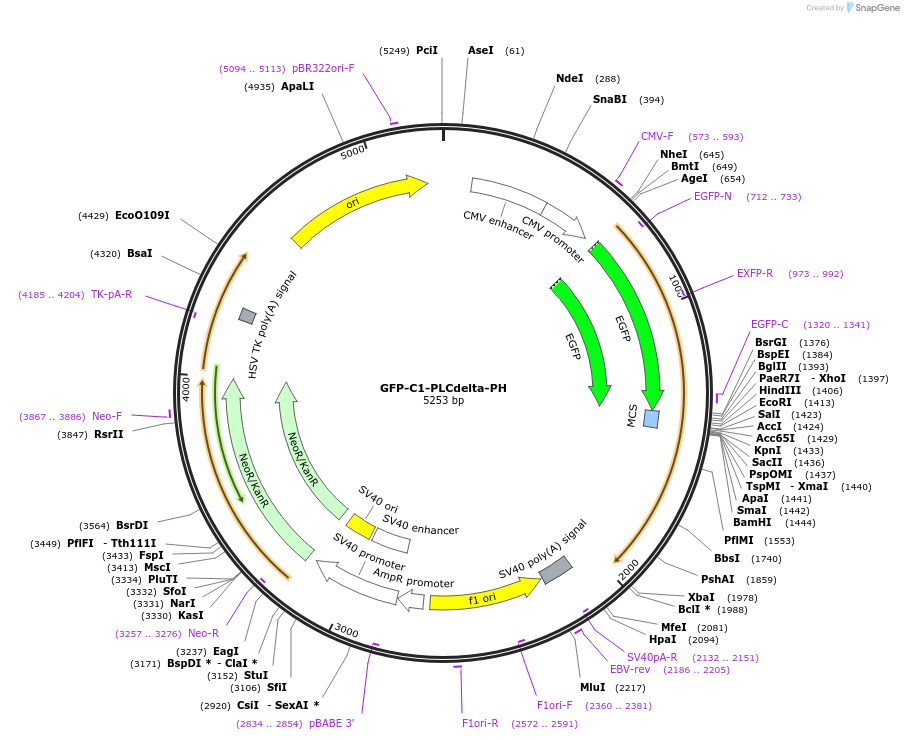-
Purposeencodes a PI(4,5)P2 lipid selective PH domain that can be used as a fluorescent translocation biosensor to monitor changes or local differences in the concentration of plasma membrane PI(4,5)P2 lipids
-
Depositing Lab
-
Publication
-
Sequence Information
Ordering
| Item | Catalog # | Description | Quantity | Price (USD) | |
|---|---|---|---|---|---|
| Plasmid | 21179 | Standard format: Plasmid sent in bacteria as agar stab | 1 | $85 | |
Backbone
-
Vector backboneC1
-
Backbone manufacturerClontech
- Backbone size w/o insert (bp) 4700
-
Vector typeMammalian Expression
-
Selectable markersNeomycin (select with G418)
Growth in Bacteria
-
Bacterial Resistance(s)Kanamycin, 50 μg/mL
-
Growth Temperature37°C
-
Growth Strain(s)DH5alpha
-
Copy numberUnknown
Gene/Insert
-
Gene/Insert namePLCdelta
-
SpeciesH. sapiens (human)
-
Insert Size (bp)529
-
MutationPH domain of human PLC delta, amino acids Met1–Ile175. (Lab plasmid WC 0003)
-
Entrez GenePLCD1 (a.k.a. NDNC3, PLC-III)
-
Tag
/ Fusion Protein
- GFP (N terminal on insert)
Cloning Information
- Cloning method Restriction Enzyme
- 5′ cloning site BamHI (unknown if destroyed)
- 3′ cloning site XbaI (unknown if destroyed)
- 5′ sequencing primer n/a (Common Sequencing Primers)
Resource Information
-
Articles Citing this Plasmid
Terms and Licenses
-
Academic/Nonprofit Terms
-
Industry Terms
- Not Available to Industry
Trademarks:
- Zeocin® is an InvivoGen trademark.
Depositor Comments
This construct encodes a PI(4,5)P2 lipid selective PH domain that can be used as a fluorescent translocation biosensor to monitor changes or local differences in the concentration of plasma membrane PI(4,5)P2 lipids (Stauffer TP, Ahn S, Meyer T; Curr Biol. 1998 8:343-6). It is best used in combination with a second fluorescent protein that uniformly marks the plasma membrane (the last 20 amino acids "CAAX" region of KRas is often used as a PM marker). Relative changes in cell-wide or local plasma membrane PI(4,5)P2 can be determined by using a mask for the PM region and by dividing the two background subtracted PH domain and CAAX images. At high expression levels, this construct interferes with PI(4,5)P2 signaling and alters cortical actin (Raucher D et al Cell. 2000 100:221-8).
These plasmids were created by your colleagues. Please acknowledge the Principal Investigator, cite the article in which the plasmids were described, and include Addgene in the Materials and Methods of your future publications.
-
For your Materials & Methods section:
GFP-C1-PLCdelta-PH was a gift from Tobias Meyer (Addgene plasmid # 21179 ; http://n2t.net/addgene:21179 ; RRID:Addgene_21179) -
For your References section:
Receptor-induced transient reduction in plasma membrane PtdIns(4,5)P2 concentration monitored in living cells. Stauffer TP, Ahn S, Meyer T. Curr Biol. 1998 Mar 12. 8(6):343-6. 10.1016/S0960-9822(98)70135-6 PubMed 9512420


